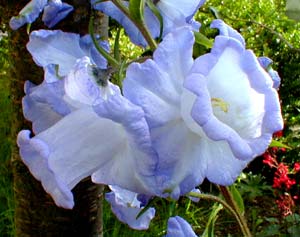
Lilac Blue
Canterbury Bells
"I can remember childhood's haunted dells
And rainbow-dusted butterflies, that fled
To hide from me in Canterbury bells."
-Robin Hyde
(1906-1939)
(1906-1939)
Campanula medium var calycanthema stands out very distinctly from regular C. medium. The variant "calcanthema" has enormous calyxes that match the color of the cup-shaped flowers, making the cup look as though it is sitting on a plate. Plus, the flower is overall quite a bit larger than regular Canterbury Bells. This variant has been commercially cultivated since 1889 when Veitch exhibited two varieties.
Cup & Saucer Canterury Bells has long held the Award of Garden Merit from the Royal Horticultural Society. They come in several colors, including the Lilac Blue shown here in a June portrait. Icy lavender spikes of flowers are so thick & heavy they will all but invariably require staking.
These are, alas, very shortlived in the garden, rarely returning for a second year of bloom, being biennials that produce basal leaves the first year, bloom the second year, then die. Nor are they as heat-hardy as many campanulas, so in warmer areas Cup & Saucers need some protection from harsh sun. Happily, here on cool Puget Sound, it wants full sun in fertile moist well-draining soil, & persists healthily throughout summer.
They bloom best from the tail-end of spring to high summer, but can be induced to keep blooming deep into autumn by deadheading. Pinching off the saucered cups one at a time as they turn brown, rather than cutting back the entire stalk, maximizes the length of time they will flower.
Dark Blue Cup & Saucer Canterbury Bells